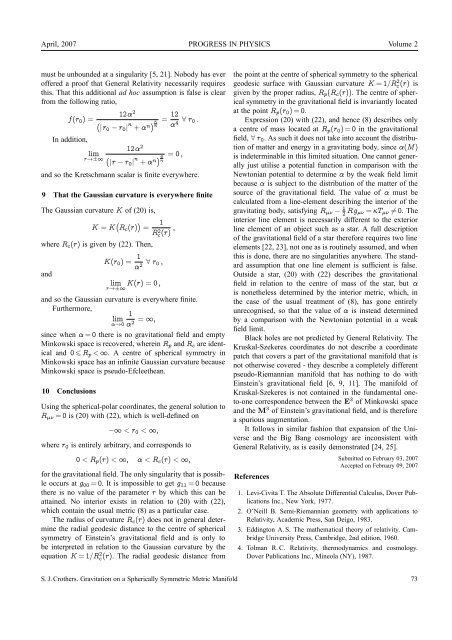ISSUE 2007 VOLUME 2 - The World of Mathematical Equations
ISSUE 2007 VOLUME 2 - The World of Mathematical Equations
ISSUE 2007 VOLUME 2 - The World of Mathematical Equations
You also want an ePaper? Increase the reach of your titles
YUMPU automatically turns print PDFs into web optimized ePapers that Google loves.
April, <strong>2007</strong> PROGRESS IN PHYSICS Volume 2<br />
must be unbounded at a singularity [5, 21]. Nobody has ever<br />
<strong>of</strong>fered a pro<strong>of</strong> that General Relativity necessarily requires<br />
this. That this additional ad hoc assumption is false is clear<br />
from the following ratio,<br />
f(r0) =<br />
In addition,<br />
lim<br />
r→±∞<br />
12α2 �<br />
|r0 − r0| n + αn�6 n<br />
12α2 �<br />
|r − r0| n + αn�6 n<br />
= 12<br />
α 4 ∀ r0 .<br />
= 0 ,<br />
and so the Kretschmann scalar is finite everywhere.<br />
9 That the Gaussian curvature is everywhere finite<br />
<strong>The</strong> Gaussian curvature K <strong>of</strong> (20) is,<br />
K = K � Rc(r) � = 1<br />
R 2 c(r) ,<br />
where Rc(r) is given by (22). <strong>The</strong>n,<br />
and<br />
K(r0) = 1<br />
α 2 ∀ r0 ,<br />
lim K(r) = 0 ,<br />
r→±∞<br />
and so the Gaussian curvature is everywhere finite.<br />
Furthermore,<br />
1<br />
lim = ∞,<br />
α→0 α2 since when α = 0 there is no gravitational field and empty<br />
Minkowski space is recovered, wherein Rp and Rc are identical<br />
and 0 � Rp < ∞. A centre <strong>of</strong> spherical symmetry in<br />
Minkowski space has an infinite Gaussian curvature because<br />
Minkowski space is pseudo-Efcleethean.<br />
10 Conclusions<br />
Using the spherical-polar coordinates, the general solution to<br />
Rμν = 0 is (20) with (22), which is well-defined on<br />
−∞ < r0 < ∞,<br />
where r0 is entirely arbitrary, and corresponds to<br />
0 < Rp(r) < ∞, α < Rc(r) < ∞,<br />
for the gravitational field. <strong>The</strong> only singularity that is possible<br />
occurs at g00 = 0. It is impossible to get g11 = 0 because<br />
there is no value <strong>of</strong> the parameter r by which this can be<br />
attained. No interior exists in relation to (20) with (22),<br />
which contain the usual metric (8) as a particular case.<br />
<strong>The</strong> radius <strong>of</strong> curvature Rc(r) does not in general determine<br />
the radial geodesic distance to the centre <strong>of</strong> spherical<br />
symmetry <strong>of</strong> Einstein’s gravitational field and is only to<br />
be interpreted in relation to the Gaussian curvature by the<br />
equation K = 1/R 2 c(r). <strong>The</strong> radial geodesic distance from<br />
the point at the centre <strong>of</strong> spherical symmetry to the spherical<br />
geodesic surface with Gaussian curvature K = 1/R2 c(r) is<br />
given by the proper radius, Rp(Rc(r)). <strong>The</strong> centre <strong>of</strong> spherical<br />
symmetry in the gravitational field is invariantly located<br />
at the point Rp(r0) = 0.<br />
Expression (20) with (22), and hence (8) describes only<br />
a centre <strong>of</strong> mass located at Rp(r0) = 0 in the gravitational<br />
field, ∀ r0. As such it does not take into account the distribution<br />
<strong>of</strong> matter and energy in a gravitating body, since α(M)<br />
is indeterminable in this limited situation. One cannot generally<br />
just utilise a potential function in comparison with the<br />
Newtonian potential to determine α by the weak field limit<br />
because α is subject to the distribution <strong>of</strong> the matter <strong>of</strong> the<br />
source <strong>of</strong> the gravitational field. <strong>The</strong> value <strong>of</strong> α must be<br />
calculated from a line-element describing the interior <strong>of</strong> the<br />
gravitating body, satisfying Rμν − 1<br />
2 Rgμν = κTμν �= 0. <strong>The</strong><br />
interior line element is necessarily different to the exterior<br />
line element <strong>of</strong> an object such as a star. A full description<br />
<strong>of</strong> the gravitational field <strong>of</strong> a star therefore requires two line<br />
elements [22, 23], not one as is routinely assumed, and when<br />
this is done, there are no singularities anywhere. <strong>The</strong> standard<br />
assumption that one line element is sufficient is false.<br />
Outside a star, (20) with (22) describes the gravitational<br />
field in relation to the centre <strong>of</strong> mass <strong>of</strong> the star, but α<br />
is nonetheless determined by the interior metric, which, in<br />
the case <strong>of</strong> the usual treatment <strong>of</strong> (8), has gone entirely<br />
unrecognised, so that the value <strong>of</strong> α is instead determined<br />
by a comparison with the Newtonian potential in a weak<br />
field limit.<br />
Black holes are not predicted by General Relativity. <strong>The</strong><br />
Kruskal-Szekeres coordinates do not describe a coordinate<br />
patch that covers a part <strong>of</strong> the gravitational manifold that is<br />
not otherwise covered - they describe a completely different<br />
pseudo-Riemannian manifold that has nothing to do with<br />
Einstein’s gravitational field [6, 9, 11]. <strong>The</strong> manifold <strong>of</strong><br />
Kruskal-Szekeres is not contained in the fundamental oneto-one<br />
correspondence between the E3 <strong>of</strong> Minkowski space<br />
and the M3 <strong>of</strong> Einstein’s gravitational field, and is therefore<br />
a spurious augmentation.<br />
It follows in similar fashion that expansion <strong>of</strong> the Universe<br />
and the Big Bang cosmology are inconsistent with<br />
General Relativity, as is easily demonstrated [24, 25].<br />
References<br />
Submitted on February 03, <strong>2007</strong><br />
Accepted on February 09, <strong>2007</strong><br />
1. Levi-Civita T. <strong>The</strong> Absolute Differential Calculus, Dover Publications<br />
Inc., New York, 1977.<br />
2. O’Neill B. Semi-Riemannian geometry with applications to<br />
Relativity, Academic Press, San Deigo, 1983.<br />
3. Eddington A. S. <strong>The</strong> mathematical theory <strong>of</strong> relativity. Cambridge<br />
University Press, Cambridge, 2nd edition, 1960.<br />
4. Tolman R. C. Relativity, thermodynamics and cosmology.<br />
Dover Publications Inc., Mineola (NY), 1987.<br />
S. J. Crothers. Gravitation on a Spherically Symmetric Metric Manifold 73

















